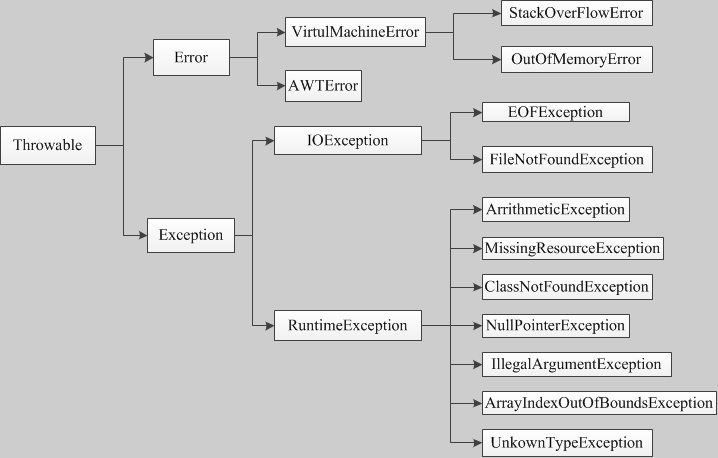Java中的异常 Exception

如图可以看出所有的异常跟错误都继承与Throwable类,也就是说所有的异常都是一个对象。
从大体来分异常为两块:
1、error---错误 : 是指程序无法处理的错误,表示应用程序运行时出现的重大错误。例如jvm运行时出现的OutOfMemoryError以及Socket编程时出现的端口占用等程序无法处理的错误。
2、Exception --- 异常 :异常可分为运行时异常跟编译异常
1)运行时异常:即RuntimeException及其之类的异常。这类异常在代码编写的时候不会被编译器所检测出来,是可以不需要被捕获,但是程序员也可以根据需要进行捕获抛出。常见的RUNtimeException有:NullpointException(空指针异常),ClassCastException(类型转换异常),IndexOutOfBoundsException(数组越界异常)等。
2)编译异常:RuntimeException以外的异常。这类异常在编译时编译器会提示需要捕获,如果不进行捕获则编译错误。常见编译异常有:IOException(流传输异常),SQLException(数据库操作异常)等。
捕获异常
使用try 和 catch 关键字可以捕获异常。try/catch 代码块放在异常可能发生的地方。
try/catch代码块中的代码称为保护代码,使用 try/catch 的语法如下:
try { // 程序代码 }catch(ExceptionName e1) { //Catch 块 }
Catch 语句包含要捕获异常类型的声明。当保护代码块中发生一个异常时,try 后面的 catch 块就会被检查。
如果发生的异常包含在 catch 块中,异常会被传递到该 catch 块,这和传递一个参数到方法是一样。
实例
下面的例子中声明有两个元素的一个数组,当代码试图访问数组的第三个元素的时候就会抛出一个异常
// 文件名 : ExcepTest.java import java.io.*; public class ExcepTest{ public static void main(String args[]){ try{ int a[] = new int[2]; System.out.println("Access element three :" + a[3]); }catch(ArrayIndexOutOfBoundsException e){ System.out.println("Exception thrown :" + e); } System.out.println("Out of the block"); } }
以上代码编译运行输出结果如下:
Exception thrown :java.lang.ArrayIndexOutOfBoundsException: 3
Out of the block
多重捕获块
一个 try 代码块后面跟随多个 catch 代码块的情况就叫多重捕获。
多重捕获块的语法如下所示:
try{ // 程序代码 }catch(异常类型1 异常的变量名1){ // 程序代码 }catch(异常类型2 异常的变量名2){ // 程序代码 }catch(异常类型2 异常的变量名2){ // 程序代码 }
上面的代码段包含了 3 个 catch块。
可以在 try 语句后面添加任意数量的 catch 块。
如果保护代码中发生异常,异常被抛给第一个 catch 块。
如果抛出异常的数据类型与 ExceptionType1 匹配,它在这里就会被捕获。
如果不匹配,它会被传递给第二个 catch 块。
如此,直到异常被捕获或者通过所有的 catch 块。
实例
该实例展示了怎么使用多重 try/catch。
try { file = new FileInputStream(fileName); x = (byte) file.read(); } catch(FileNotFoundException f) { // Not valid! f.printStackTrace(); return -1; } catch(IOException i) { i.printStackTrace(); return -1; }
throws/throw 关键字
将异常抛出 public class ExceptionTest2 { public void method() throws Exception // 将异常抛出,由调用这个方法的方法去处理这个异常,如果main方法也将异常抛出,则交给Java虚拟机来处理 { System.out.println("Hello World"); // 抛出异常 throw new Exception(); } public static void main(String[] args) throws Exception // main方法选择将异常继续抛出 { ExceptionTest2 test = new ExceptionTest2(); test.method(); // main方法需要对异常进行处理 // 执行结果: // Hello World // Exception in thread "main" java.lang.Exception // at com.learnjava.exception.ExceptionTest2.method(ExceptionTest2.java:10) // at com.learnjava.exception.ExceptionTest2.main(ExceptionTest2.java:17) } }
对于运行时异常(runtime exception),可以对其进行处理,也可以不处理。推荐不对运行时异常进行处理。
自定义异常
所谓自定义异常,通常就是定义一个类,去继承Exception类或者它的子类。因为异常必须直接或者间接地继承自Exception类。
通常情况下,会直接继承自Exception类,一般不会继承某个运行时的异常类。
自定义异常可以用于处理用户登录错误,用户输入错误提示等。
自定义异常的例子:
自定义一个异常类型
public class MyException extends Exception { public MyException() { super(); } public MyException(String message) { super(message); } }
一种异常处理方式:
public class ExceptionTest4 { public void method(String str) throws MyException { if(null == str) { throw new MyException("传入的字符串参数不能为null!"); } else { System.out.println(str); } } public static void main(String[] args) throws MyException //异常处理方式1,不断向外抛出 { ExceptionTest4 test = new ExceptionTest4(); test.method(null); } }
另一种异常处理方式:
public class ExceptionTest4 { public void method(String str) throws MyException { if (null == str) { throw new MyException("传入的字符串参数不能为null!"); } else { System.out.println(str); } } public static void main(String[] args) { //异常处理方式2,采用try...catch语句 try { ExceptionTest4 test = new ExceptionTest4(); test.method(null); } catch (MyException e) { e.printStackTrace(); } finally { System.out.println("程序处理完毕"); } } }
finally关键字
finally 关键字用来创建在 try 代码块后面执行的代码块。
无论是否发生异常,finally 代码块中的代码总会被执行。
在 finally 代码块中,可以运行清理类型等收尾善后性质的语句。
finally 代码块出现在 catch 代码块最后
实例
public class ExcepTest{ public static void main(String args[]){ int a[] = new int[2]; try{ System.out.println("Access element three :" + a[3]); }catch(ArrayIndexOutOfBoundsException e){ System.out.println("Exception thrown :" + e); } finally{ a[0] = 6; System.out.println("First element value: " +a[0]); System.out.println("The finally statement is executed"); } } } //运行结果如下 //Exception thrown :java.lang.ArrayIndexOutOfBoundsException: 3 //First element value: 6 //The finally statement is executed